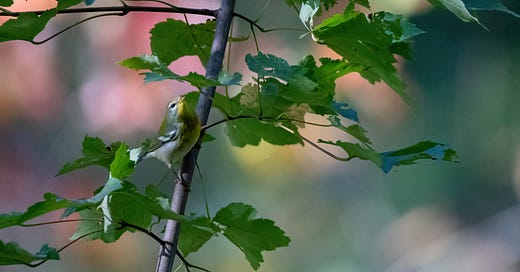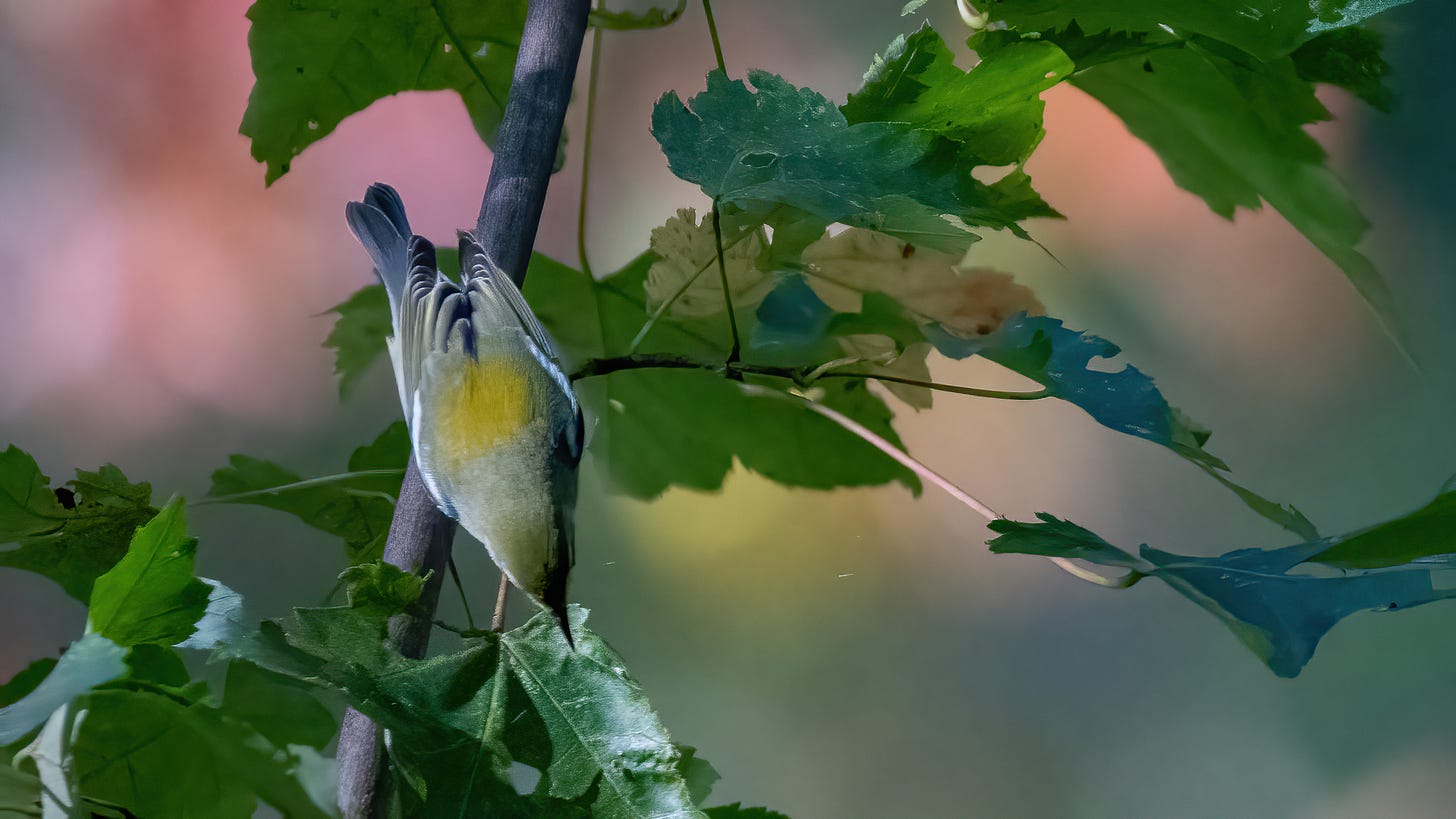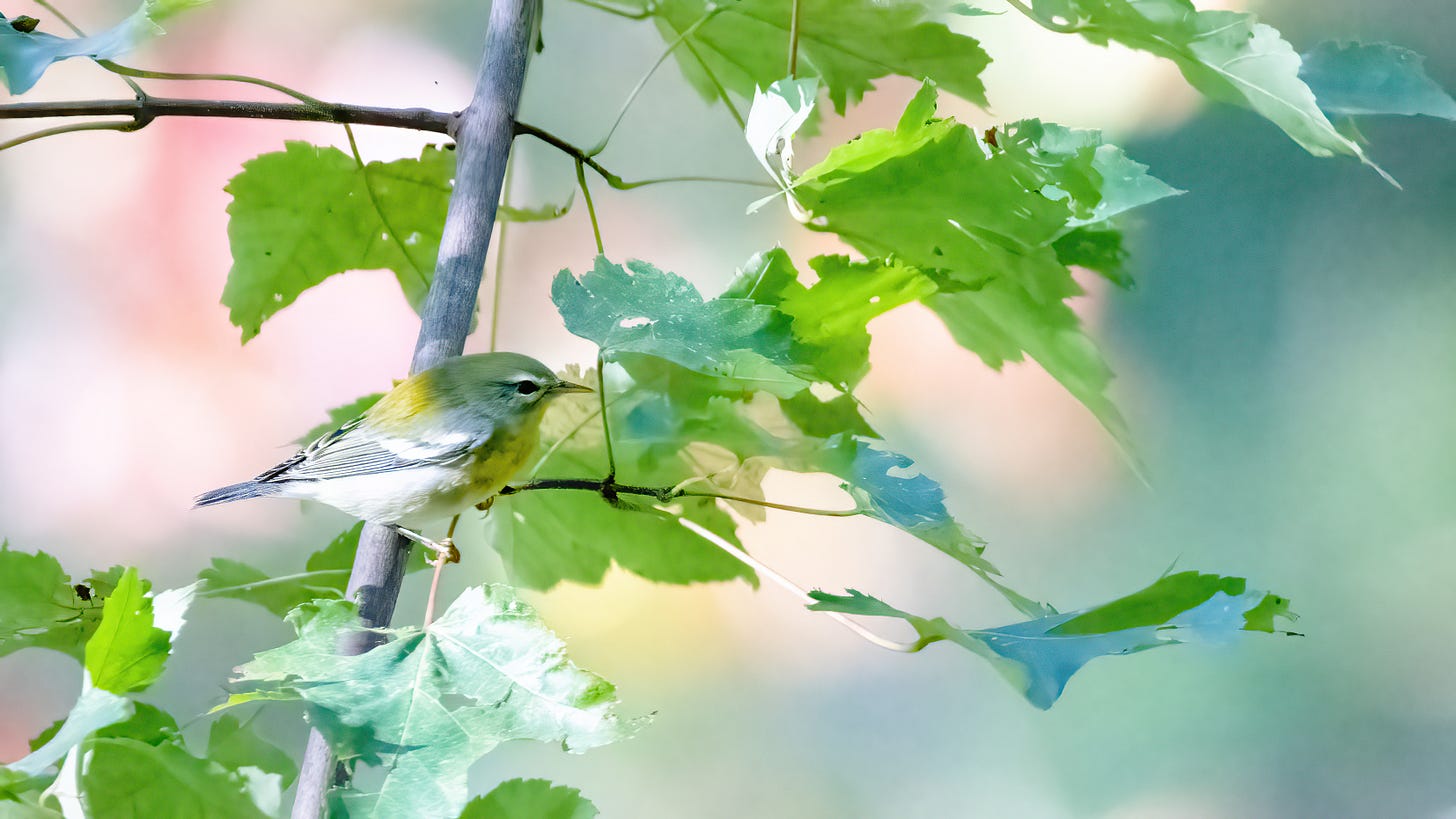Slacking on Species Saturdays. Here’s a shorter one. Been fiddling with this one for a bit—another about Pileated Woodpeckers, one about Sanderlings. I try to have these for Saturday mornings, but this one is late. Still Saturday.
Northern Parulas move around a lot. “Very small and active,” as described in my copy of The Warbler Guide. Having tried to photograph them, I can attest to this.
Before you worry about seeing one of these birds, worry about how to say the name. I never did until I realized I might’ve been saying it wrong. I’ve always said Northern Pa-RU-la.
The American Bird Conservancy clarifies: “You'll hear birders say, ‘Look, there's a Northern ‘Pa-RU-la,' or ‘PAIR-a-la,' or ‘PAR-ya-la.’” It concludes, “Different sources say the correct pronunciation is ‘PAR-you-lah,’ and ‘PAR-a-la.’ Either way, the accent is on the first syllable.” So I have been wrong. PAR-you-lah or PAR-a-la, not Pa-RU-la.
Pronunciation aside, one of the things I love about the Northern Parula is that it has eschewed the “[physical description/naturalist or ornithologist’s last name/naturalist’s family member’s name] Warbler” naming convention for warblers—despite technically being warblers.
The Northern Parula thumbs its nose at the standard imposed upon Yellow Warblers, which are yellow, or Black-and-white Warblers, which are—you guessed it—black and white. (Migratory aside: While ambling about this morning, 5/19 as I write, I heard both these birds.) It is helpful to have names based on physical descriptions to work from when you see a bird, though. On the other hand, the Blackburnian Warbler is named after a naturalist or her brother, and Kirtland’s Warbler is named for the owner of the farm where that bird was established.
The Northern Parula name isn’t free of a story. As noted by the Cornell Lab of Ornithology, “before this species received the name Northern Parula (a diminutive form of parus, meaning little titmouse), Mark Catesby, an English naturalist, called it a ‘finch creeper’ and John James Audubon and Alexander Wilson called it a ‘blue yellow-backed warbler.’” Finch creeper is not so bad. Blue yellow-backed warbler is not great if we want to thumb our noses at warbler naming conventions.
If you are familiar with the Northern Parula (I am repeating in my head: PARyoulah, PARyoulah, PAR-youuu-lah), you are likely familiar with the sounds they make—which I’ve seen described as “buzzy” and “easy to ID.” There are a few sounds these birds make, but we’ll just focus on one.

I’d guess the most widely known vocalization these birds make—“most common” per The Warbler Guide—is their trilling crescendo. You know this trill is over when the bird makes an abrupt chirplike noise. To cite The Warbler Guide again, “a fast up/down accented slur; length and quality can vary.” If you’d rather, you can just listen for yourself instead of trudging through my attempts at description. Maybe you’ll hear it and realize, I’ve heard that outside before!
What else about the Northern Parula? Well if I was asked to quickly describe one, I’d say tiny, kind of grayish blue with yellow. The throat is yellow, so is the breast and lower mandible, but there’s also a patch of yellow on the back. This patch has been described elsewhere as yellowish green, but to me it’s just yellow. The green parts, to me, are just around the edges—which I chalk up to a yellow patch plus a grayish or bluish body. Blue plus yellow does in fact make green.
Something else worth noting about the Northern Parula is that it has good population numbers. Audubon describes the conservation status as: “Still widespread and common, numbers apparently stable.” Don’t lose any sleep over the wellbeing of Northern Parulas. They are doing okay.
Too often with interesting or good-looking birds the numbers are dipping. I said “too often,” not “always”—because there are exceptions. The Northern Parula being one of them. The above quoted American Bird Conservancy tallies population numbers as 18 million and increasing.
Let’s be happy they are increasing. These birds aren’t always easy to see—have a preference to be higher in the trees—but at least any difficulties you have when trying to see them aren’t anything to do with a lack of birds, with poor population numbers. They don’t like to sit sill; Audubon explains that the Northern Parula “is often hard to see as it forages in dense foliage of the treetops.” So these birds might be hard to see, but there are in fact plenty of Northern Parulas out there to see or hear.








